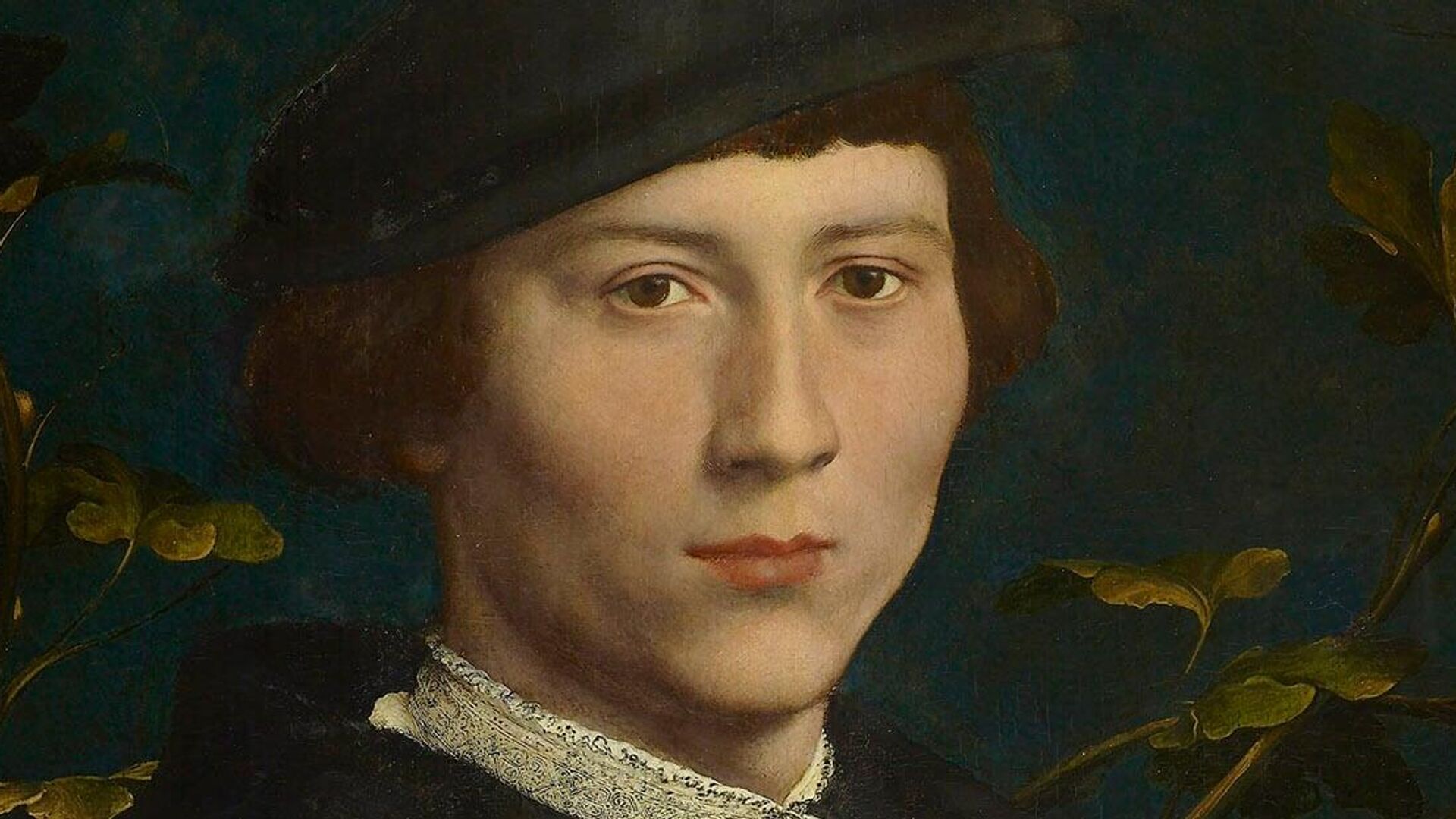https://sputnikglobe.com/20231112/advanced-imaging-reveals-artistic-secrets-of-16th-century-hans-holbein-painting-1114897969.html
Advanced Imaging Reveals Artistic Secrets of 16th Century Hans Holbein Painting
Advanced Imaging Reveals Artistic Secrets of 16th Century Hans Holbein Painting
Sputnik International
Subtle facial alterations discovered in the artworks of Holbein provide new insights into his artistic methods and practices during the Tudor era.
2023-11-12T13:45+0000
2023-11-12T13:45+0000
2023-11-12T13:45+0000
beyond politics
hans holbein
henry viii
david born
royal collection trust
society
newsfeed
https://cdn1.img.sputnikglobe.com/img/07e7/0b/0c/1114898638_222:0:1333:625_1920x0_80_0_0_1bdf3dbd5c35e8e99bc13a914ae37048.jpg
The recent conservation work on portraits by Hans Holbein, a prominent artist during the reign of Henry VIII, has uncovered fascinating insights into early artistic techniques resembling modern-day contouring. This discovery challenges the notion that such methods were a recent development, suggesting their roots can be traced back to the 16th century.A detailed examination of the portrait of Derich Born, a German merchant, revealed subtle changes in the depiction of his facial features. Advanced techniques like X-ray and infrared scans have exposed how Holbein gradually refined Born's jawline, adding successive layers of paint to achieve a more sculpted appearance. While not documented in historical records, this process raises questions about whether these alterations were made at Born's request or were solely painter’s artistic choices.Further insights were gained through high-resolution technical imaging conducted by the Getty Conservation Institute. The analysis enabled experts to observe Holbein's underdrawing techniques, notably how he varied line weight and quality to enhance Born's facial contours. Nicola Christie, the head of paintings conservation at Royal Collection Trust, shared these findings with the media.The original inscription on the painting praised its lifelike quality, stating, "If you added a voice, this would be Derich (Born) his very self. You would be in doubt whether the painter or his father made him." The restoration process, however, unveiled a thumbprint—likely Holbein's—on the panel's left edge. This discovery, along with the paint’s drying process, suggests a more intricate and time-consuming process than initially thought.Reflecting on these findings, Kate Heard, curator of Holbein at the Tudor Court, admired Holbein's skill. Nearly half a millennium later, his ability to depict his subjects' core characteristics with such accuracy continues to astonish people and offers new perspectives on his contributions to the art world.
https://sputnikglobe.com/20220320/researchers-discover-new-details-about-hidden-portrait-beneath-pablo-picasso-painting-1094030471.html
Sputnik International
feedback@sputniknews.com
+74956456601
MIA „Rossiya Segodnya“
2023
Chimauchem Nwosu
https://cdn1.img.sputnikglobe.com/img/07e7/09/01/1113046371_0:99:1536:1635_100x100_80_0_0_9c5c627283eca931c39fe4852bbb301c.jpg
Chimauchem Nwosu
https://cdn1.img.sputnikglobe.com/img/07e7/09/01/1113046371_0:99:1536:1635_100x100_80_0_0_9c5c627283eca931c39fe4852bbb301c.jpg
News
en_EN
Sputnik International
feedback@sputniknews.com
+74956456601
MIA „Rossiya Segodnya“
Sputnik International
feedback@sputniknews.com
+74956456601
MIA „Rossiya Segodnya“
Chimauchem Nwosu
https://cdn1.img.sputnikglobe.com/img/07e7/09/01/1113046371_0:99:1536:1635_100x100_80_0_0_9c5c627283eca931c39fe4852bbb301c.jpg
hans holbein, tudor era art, portrait conservation, early modern contouring, 16th century artistic techniques, derich born portrait , getty conservation institute, hans holbein art x-ray analysis, infrared scans in art, royal collection trust, historical portrait restoration, advanced imaging in art, renaissance art techniques , artistic innovation tudor period, holbein facial contouring.
hans holbein, tudor era art, portrait conservation, early modern contouring, 16th century artistic techniques, derich born portrait , getty conservation institute, hans holbein art x-ray analysis, infrared scans in art, royal collection trust, historical portrait restoration, advanced imaging in art, renaissance art techniques , artistic innovation tudor period, holbein facial contouring.
Advanced Imaging Reveals Artistic Secrets of 16th Century Hans Holbein Painting
Subtle facial alterations discovered in the artworks of Holbein provide new insights into his artistic methods and practices during the Tudor era.
The recent conservation
work on portraits by Hans Holbein, a prominent artist during the reign of Henry VIII, has uncovered fascinating insights into early artistic techniques resembling modern-day contouring. This discovery challenges the notion that such methods were a recent development, suggesting their roots can be traced back to the 16th century.
A detailed examination of the portrait of Derich Born, a German merchant, revealed subtle changes in the depiction of his facial features. Advanced techniques like X-ray and infrared scans have exposed how Holbein gradually refined Born's jawline, adding successive layers of paint to achieve a more sculpted appearance. While not documented in historical records, this process raises questions about whether these alterations were made at Born's request or were solely painter’s artistic choices.
Further insights were gained through high-resolution technical imaging conducted by the Getty Conservation Institute. The analysis enabled experts to observe Holbein's underdrawing techniques, notably how he varied line weight and quality to enhance Born's facial contours. Nicola Christie, the head of paintings conservation at Royal Collection Trust, shared these findings with the media.
“We can clearly see that Holbein continued to perfect the cheek and jawline in the two layers of azurite blue background until he – and perhaps Derich too – was finally satisfied with the likeness…The slightly chubby youth in the X-ray image emerges as the chisel-jawed young man in the painting,” Christie noted.
The original inscription on the painting praised its lifelike quality, stating, "If you added a voice, this would be Derich (Born) his very self. You would be in doubt whether the painter or his father made him." The restoration process, however, unveiled a thumbprint—likely Holbein's—on the panel's left edge. This discovery, along with the paint’s drying process, suggests a more intricate and time-consuming process than initially thought.
Reflecting on these findings, Kate Heard, curator of Holbein at the Tudor Court, admired Holbein's skill. Nearly half a millennium later, his ability to depict his subjects' core characteristics with such accuracy continues to astonish people and offers new perspectives on his contributions to the art world.
In 1526, Holbein arrived in England and was later designated as the King's painter, earning a £30 (equivalent to £21,000 today) yearly wage during a tumultuous time in Henry VIII’s rule.
He was famous for his flattering artistic portrayal of the German Princess Anne of Cleves, which influenced Henry VIII's decision to wed her as his fourth wife, according to historians.
Holbein's artistic legacy includes portraits of three other wives of Henry VIII – Anne Boleyn, Jane Seymour, and Katherine Howard – and his heir, Edward VI.
Other paintings cover famous Tudor courtiers like Sir Thomas More, Thomas Howard, the 3rd Duke of Norfolk.




